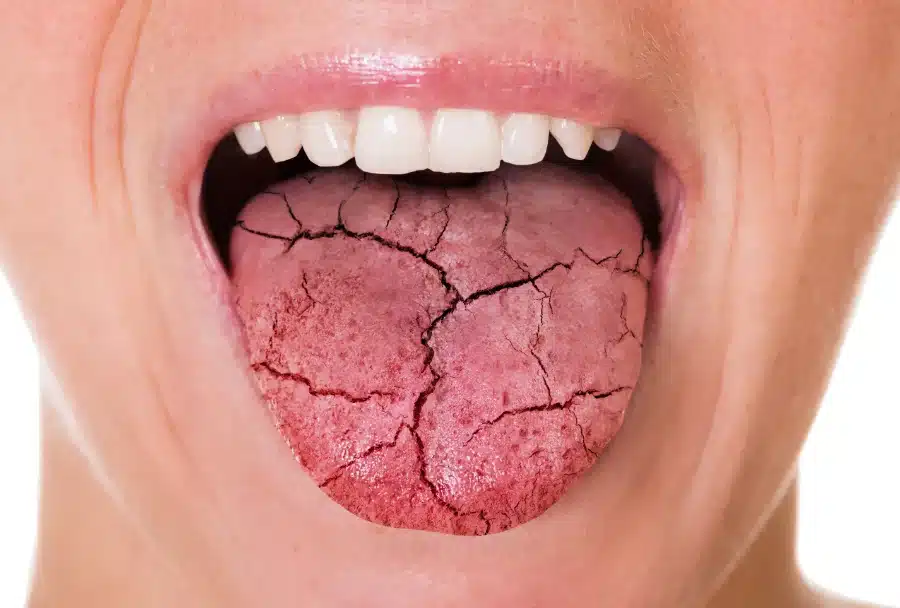


In this blog, we will explore the science behind mouth breathing, debunk common myths, discuss the benefits and drawbacks of breathing through mouth, and provide strategies to optimize mouth breathing for better overall health.
Breathing is a vital function that provides our bodies with the oxygen it needs to survive and allows us to release carbon dioxide and waste. Most people naturally use both their nose and mouth to breathe. However, there are times when mouth breathing becomes necessary, such as when the nasal passages are congested due to allergies or a cold. Additionally, during strenuous exercise, breathing through the mouth can help deliver oxygen to the muscles faster.
While mouth breathing can be temporary and serve a purpose in certain situations, chronic mouth breathing can lead to various health issues. In adults, it can result in bad breath and gum disease. Mouth breathing can also worsen symptoms of other illnesses and affect overall health.
Key Highlights

Mouth breathing occurs when people exclusively breathe through their mouths instead of using their nasal passages. This can be due to various reasons, such as nasal congestion from allergies or a cold. In some cases, chronic mouth breathing may be a result of underlying conditions like sleep apnea or a habit developed over time.
Chronic mouth breathing refers to consistently breathing through the mouth, even during sleep. It can have implications for oral and overall health, including the development of facial deformities, crooked teeth, and poor growth in children. Understanding the science behind mouth breathing can help us explore its benefits and drawbacks.
Breathing through the mouth affects the body’s respiratory system and blood vessels. When we breathe through the nose, the nasal passages act as filters, trapping small particles like pollen and adding moisture to the air. The nose also produces nitric oxide, a gas that improves lung function, dilates blood vessels, and has antifungal, antiviral, antiparasitic, and antibacterial properties.
In contrast, breathing through the mouth bypasses these filtration and moisture-warming processes. It can result in a drier mouth and throat, reducing the production of saliva and increasing the risk of bad breath. Mouth breathing also affects the body’s ability to absorb oxygen efficiently and can impact overall respiratory health.

There are several common myths surrounding mouth breathing that need to be addressed. One myth is that mouth breathing leads to a dry mouth. While it’s true that breathing through the mouth can cause dryness, it’s not the sole cause of dry mouth. Other factors like dehydration and medications can also contribute to this condition.
Another myth is that mouth breathing causes bad breath. While mouth breathing can contribute to bad breath, it is not the sole cause. Poor oral hygiene and certain foods can also play a role in halitosis.
It’s important to understand that chronic mouth breathing can have health implications beyond oral health. It can exacerbate symptoms of allergies, asthma, and other respiratory conditions. It may also affect sleep quality and contribute to fatigue and cognitive issues.
Despite the drawbacks of chronic mouth breathing, there are also potential benefits, especially in certain situations. Breathing through the mouth can enhance exercise performance, particularly for activities that involve large muscle groups and require intense exertion. When we breathe through the mouth during exercise, we increase oxygen intake, which can improve physical performance.
Mouth breathing also activates the sympathetic nervous system, which is responsible for the “fight or flight” response. This activation can help with stress relief and enhance our ability to cope with challenging situations.

Breathing through the mouth during intense exercise can have specific benefits for performance. When we breathe through the mouth, we increase oxygen intake, allowing more oxygen to reach the muscles. This increased oxygen delivery can improve endurance and overall physical performance.
Benefits of mouth breathing during exercise include:
By focusing on proper breathing techniques and utilizing mouth breathing during intense exercise, individuals can optimize their performance and achieve their fitness goals.
Mouth breathing can also play a role in stress relief. When we breathe through the mouth, it activates the sympathetic nervous system, which is responsible for the body’s response to stress and perceived threats. This activation leads to shallow, rapid, and abnormal breathing patterns associated with stress.
By practicing conscious mouth breathing during stressful situations, individuals can activate the sympathetic nervous system and promote relaxation. This can help manage stress levels and improve overall well-being. Incorporating mindfulness techniques and breathing exercises that focus on mouth breathing can be effective strategies for stress management.

While there are benefits to mouth breathing in certain contexts, chronic mouth breathing can have significant drawbacks. One of the main concerns is its impact on oral health. Breathing through the mouth can lead to dry mouth, which reduces saliva production and increases the risk of tooth decay, gum disease, and other oral health issues.
Additionally, mouth breathing can negatively affect sleep quality. It can contribute to snoring, sleep apnea, disrupted sleep patterns and sleeplessness, leading to daytime fatigue and cognitive difficulties.
Chronic mouth breathing can have detrimental effects on oral health. When we breathe through our mouths, it reduces saliva production, leading to a dry mouth. Saliva plays a crucial role in maintaining oral health by washing away bacteria and neutralizing acids.
Reduced saliva flow increases the risk of gum disease, tooth decay, and other dental problems. Gum disease, in particular, can be exacerbated by mouth breathing, as the dry environment promotes bacterial growth, chronic colds and inflammation.
It is important for individuals who experience chronic mouth breathing to be aware of the potential impact on their oral health. Regular dental check-ups, proper oral hygiene practices, and managing nasal congestion can help mitigate the risks associated with mouth breathing.

While there are drawbacks to chronic mouth breathing, there are strategies individuals can employ to optimize their breathing patterns. These strategies focus on improving nasal congestion and respiratory muscle strength.
Breathing exercises can help improve mouth breathing efficiency by strengthening the respiratory muscles and promoting proper breathing patterns. These exercises may include diaphragmatic breathing, pursed lip breathing, and alternate nostril breathing.
Another strategy is addressing nasal congestion, which may involve using nasal sprays, nasal strips, or seeking medical treatment for underlying conditions contributing to congestion. By optimizing nasal airflow, individuals can reduce the need for mouth breathing and improve overall respiratory health.
Breathing exercises can be beneficial in improving mouth breathing efficiency. These exercises focus on strengthening the respiratory muscles and promoting proper breathing patterns. Some effective breathing exercises include:
By incorporating these breathing exercises into a daily routine, individuals can enhance mouth breathing efficiency, improve respiratory muscle strength, and optimize overall breathing patterns.

Common challenges associated with mouth breathing include dry mouth and nasal obstruction. Dry mouth can be alleviated by staying hydrated, practicing good oral hygiene, and using saliva substitutes or oral moisturizers. Nasal obstruction can be addressed through medical interventions such as nasal sprays, decongestants, or surgery if necessary. It is important to work with healthcare professionals to identify and address the underlying causes of these challenges to improve overall respiratory health.
Dry mouth during the night can be a common problem for mouth breathers, and CPAP users. When you breathe through your mouth, the natural flow of saliva is disrupted, leading to dryness. Saliva plays a vital role in oral health by washing away bacteria and helping to prevent tooth decay and gum disease. Additionally, using a CPAP machine can be very drying as well. The continuous dry airflow can remove moisture from your oral cavity. To mitigate this, consider using a saliva substitute to add moisture to the mouth to reduce dryness. It also aids in digestion and promotes a comfortable sleep by keeping the mouth moisturized.
To overcome dry mouth during the night, it is important to promote saliva production and maintain hydration. Drinking plenty of water throughout the day helps keep your entire body, including your mouth, hydrated. Using a humidifier in your bedroom can add moisture to the air while you sleep. Applying a dry mouth spray before bed acts as a saliva substitute, helping to retain necessary moisture in your mouth. Additionally, practicing good oral hygiene, including regular brushing and flossing, can support healthy saliva flow..

Chronic mouth breathing can have negative effects on dental health, including bad breath, gum disease, and tooth decay. When you breathe through your mouth, the saliva that helps wash away bacteria and neutralize acids in the mouth is reduced, leading to an imbalance in oral health.
To prevent these negative effects on dental health, it is important to prioritize oral hygiene. Brushing your teeth at least twice a day with fluoride toothpaste and flossing daily can help remove plaque and prevent tooth decay. Regular dental check-ups and cleanings are also essential to maintain oral health and address any issues promptly.
Using a product like Lubricity Dry Mouth Spray or Lubricity Xtra Moisturizing spray, can help by being a saliva substitute to increase the moisture in your mouth. Avoiding sugary and acidic foods and drinks can also help maintain a healthy oral environment. These products are made from all natural ingredients to provide effective relief without all the extra additives you find in other brands.
Integrating mouth breathing into your wellbeing or yoga routine can provide numerous benefits, particularly during meditation and relaxation techniques. Mouth breathing during these practices can help promote a sense of calm, deep relaxation, and mindfulness.
During meditation, breathing through the mouth can help regulate the breath and bring awareness to the present moment. It can also enhance the relaxation response and alleviate stress and anxiety. Similarly, during relaxation techniques such as deep breathing exercises or progressive muscle relaxation, mouth breathing can aid in releasing tension and promoting a state of relaxation.
By incorporating mouth breathing into your wellbeing routine, you can enhance the effectiveness of these practices and achieve a greater sense of peace and tranquility.

Years ago, I added to my meditation practices for my mind and my body. This Mantra Meditation was used to slow down my breathing and open up my airways. I would breathe in through my nose to the count of 4 and out through the mouth to the count of 5. After 4 to 5 deep breathes, my breathing would go back to normal, and I would start the meditation. One great advantage is that you can do it anywhere — indoors, or out, just choose a spot where you’re least likely to be distracted, and then follow these steps:
Some people find it helpful to use visual imagery, such as imagining light emitting from your heart or the person you’re thinking of.
Feel free to change the phrase and make it your own.
Mouth breathing can be particularly beneficial for stress relief and mindfulness during meditation and relaxation practices. When you consciously breathe through your mouth, you engage the diaphragm and activate the parasympathetic nervous system, which promotes relaxation and reduces stress.
Using mouth breathing techniques during meditation allows you to deepen your breath and release tension. It can help quiet the mind, bring focus to the present moment, and enhance your overall mindfulness experience. By focusing on the sensation of the breath entering and leaving your mouth, you can cultivate a sense of calm and relaxation.
When practicing relaxation techniques, such as deep breathing exercises or progressive muscle relaxation, mouth breathing can aid in releasing tension and promoting a state of relaxation. It allows for a deeper, more expansive breath, which helps activate the body’s relaxation response and reduce stress.

While mouth breathing can have its benefits, it is important to strike a balance between nose breathing and mouth breathing for optimal health. Nasal breathing is the body’s natural and preferred method of breathing, and it offers several health benefits.
Nasal breathing filters the air, trapping particles and allergens, and adds moisture to the air, preventing dryness in the lungs and bronchial tubes. It also warms up cold air before it reaches the lungs and increases oxygen uptake by maintaining the elasticity of the lungs. Additionally, nasal breathing stimulates the production of nitric oxide, a molecule that has numerous health benefits, including improving lung function and supporting the immune system.
By balancing nose breathing and mouth breathing, you can reap the benefits of both techniques. Paying attention to your breathing patterns and consciously incorporating both methods when appropriate can contribute to overall wellbeing and optimal health.
In conclusion, mastering mouth breathing techniques can have a significant impact on your overall well-being. Understanding the science, benefits, drawbacks, and strategies to optimize mouth breathing is crucial for improving exercise performance, stress relief, and overall health. Addressing challenges like dry mouth and dental health issues is essential for successful integration into your daily routine. By incorporating efficient mouth breathing practices and utilizing appropriate tools and exercises, you can enhance your physical and mental health. Remember, the key is to find a balance between nose and mouth breathing for optimal results and overall wellness.
Breathing through your mouth while sleeping can have negative effects on your health. It can contribute to sleep apnea, snoring, dry mouth, sore throat, and other health complications. If you suspect that you are breathing through your mouth while sleeping, it is important to consult with a healthcare professional for evaluation and appropriate treatment.
Mouth breathing in adults can be corrected through various interventions. Addressing underlying causes, such as nasal obstruction or certain health conditions, is essential. Breathing retraining exercises and techniques, along with guidance from healthcare providers, can help transition from mouth breathing to nasal breathing.
There are specific times when mouth breathing can be beneficial. During intense exercise, mouth breathing allows for increased oxygen intake. Additionally, during moments of stress or when experiencing nasal congestion, mouth breathing can provide relief and help regulate the breath.
The first steps to transitioning to healthy mouth breathing practices include incorporating breathing exercises into your routine, practicing nasal breathing whenever possible, and paying attention to your breathing patterns. Keeping the nasal passages clear and maintaining a healthy overall lifestyle can also support optimal mouth breathing.